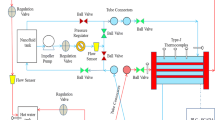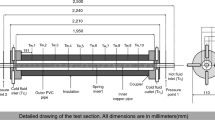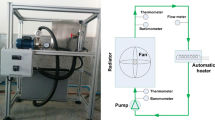Abstract
Heat transfer enhancement plays a very important role for energy saving in plate-fin heat exchangers. In the present study, the influences of simultaneous utilization of a louvered plate-fin channel and copper-base deionized water nanofluid on performance of these exchangers are experimentally explored. The effects of flow rate (2–5 l/min) and nanoparticles weight fraction (0–0.4 %) on heat transfer and pressure drop characteristics are determined. Experimental results indicate that the use of louvered channel instead of the plain one can improve the heat transfer performance. Likewise, addition of small amounts of copper nanoparticles to the base fluid augments the convective heat transfer coefficient remarkably. The maximum rise of 21.7 % in the convective heat transfer coefficient is observed for the 0.4 % wt nanofluid compared to the base fluid. Also, pumping power for the base fluid and nanofluids are calculated based on the measured pressure drop in the louvered channel. The average increase in pumping power is 11.8 % for the nanofluid with 0.4 % wt compared to the base fluid. Applied performance criterion shows a maximum performance index of 1.167 for the nanofluid with 0.1 % wt Finally, two correlations are proposed for Nusselt number and friction factor which fit the experimental data with in ±10 %.












Similar content being viewed by others
Abbreviations
- A c :
-
Minimum free flow area (m2)
- A t :
-
Total surface area in contact with working fluid (m2)
- C p :
-
Specific heat (J kg−1 K−1)
- D h :
-
Hydraulic diameter (m)
- G :
-
Mass velocity (kg m−2 s−1)
- h :
-
Average heat transfer coefficient (W m−2 K−1)
- L :
-
Channel length (m)
- l/min:
-
Litter per minute (l min−1)
- M :
-
Number of the independent variables
- m :
-
Mass flow rate (kg s−1)
- Q:
-
Convective heat transfer rate (W)
- T :
-
Temperature (K)
- P :
-
Pressure (Pa)
- R :
-
Dependent variable
- X :
-
Independent variables
- ρ :
-
Density (kg m−3)
- μ :
-
Dynamic viscosity (kg m−1 s−1)
- κ :
-
Thermal conductivity (W m−1 K−1)
- φ :
-
Nanoparticle weight fraction
- δ t :
-
Thermal boundary layer
- BF :
-
Base fluid
- in :
-
Inlet
- out :
-
Outlet
- f :
-
Fluid
- j :
-
Specific parameter counter
- LMTD :
-
Logarithmic mean temperature difference
- NF :
-
Nanofluid
- w :
-
Wall
- f :
-
Fanning friction factor = ρD h ∆P/2LG 2
- Nu :
-
Nusselt number = hD h /κ
- Pr :
-
Prandtl number = μC p /κ
- Re :
-
Reynolds number = GD h /μ
- EEW:
-
Electro-exploded wire
- PEC:
-
Performance evaluation criteria
- PFHE:
-
Plate-fin heat exchanger
- TEM:
-
Transmission electron microscope
References
Bergles AE (1983) Augmentation of heat transfer. Heat Exchanger Design Handbook. Hemisphere Publishing Company, Washington DC
Huminic G, Huminic A (2012) Application of nanofluids in heat exchangers: a review. Renew Sustain Energy Rev 16:5625–5638
Santra AK, Sen S, Chakraborty N (2009) Study of heat transfer due to laminar flow of copper-water nanofluid through two isothermally heated parallel plates. Int J Therm Sci 48:391–400
Heidary H, Kermani MJ (2010) Effect of nano-particles on forced convection in sinusoidal-wall channel. Int Commun Heat Mass Transf 37:1520–1527
Heidary H, Kermani MJ (2012) Heat transfer enhancement in a channel with block(s) effect and utilizing nano-fluid. Int J Therm Sci 57:163–171
Ahmed MA, Shuaib NH, Yusoff MZ, Al-Falahi AH (2011) Numerical investigations of flow and heat transfer enhancement in a corrugated channel using nanofluid. Int Commun Heat Mass Transf 38:1368–1375
Ahmed MA, Shuaib NH, Yusoff MZ (2012) Numerical investigations on the heat transfer enhancement in a wavy channel using nanofluid. Int J Heat Mass Transf 55:5891–5898
Ahmed MH, Yusoff MZ, Shuaib NH (2013) Effects of geometrical parameters on the flow and heat transfer characteristics in trapezoidal-corrugated channel using nanofluid. Int Commun Heat Mass Transf 42:69–74
Pandey SD, Nema VK (2012) Experimental analysis of heat transfer and friction factor of nanofluid as a coolant in a corrugated plate heat exchanger. Exp Thermal Fluid Sci 38:248–256
Ahmed HE, Mohammed HA, Yusoff MZ (2012) Heat transfer enhancement of laminar nanofluids flow in a triangular duct using vortex generator. Superlattices Microstruct 52:398–415
Payamavaran Nanotechnology Fardanegar (PNF) Nano Engineering & Manufacturing Co. www.pnf-co.com
Duangthongsuk W, Wongwises S (2008) Effect of thermophysical properties models on the predicting of the convective heat transfer coefficient for low concentration nanofluid. Int Commun Heat Mass Transfer 35:1320–1326
Kays WM, London AL (1984) Compact heat exchangers, 3rd edn. McGraw-Hill, New York
Kline SJ, McClintock FA (1953) Describing uncertainties in single-sample experiments. Mechanical Engineering 75:3–8
Holman JP (1995) Heat and mass transfer, 5th edn. Mcgraw Hill, New York
Kim D, Kwon Y, Cho Y, Li C, Cheong S, Hwang Y, Lee J, Hong D, Moon S (2009) Convective heat transfer characteristics of nanofluids under laminar and turbulent flow conditions. Curr Appl Phys 9:119–123
Duangthongsuk W, Wongwises S (2010) An experimental study on the heat transfer performance and pressure drop of TiO2-water nanofluids flowing under a turbulent flow regime. Int J Heat Mass Transf 53:334–344
Maiga SEB, Nguyen CT, Galanis N, Roy G (2004) Heat transfer behaviors of nanofluids in a uniformly heated tube. Superlattices Microstruct 35:543–557
Fotukian SM, Nasr Esfahany M (2010) Experimental investigation of turbulent convective heat transfer of dilute γ-Al2O3/water nanofluid inside a circular tube. Int J Heat Fluid Flow 31:606–612
Razi P, Akhavan-Behabadi MA, Saeedinia M (2011) Pressure drop and thermal characteristics of CuO–base oil nanofluid laminar flow in flattened tubes under constant heat flux. Int Commun Heat Mass Transf 38:964–971
Acknowledgments
The authors would like to express their thanks to University of Semnan and Materials and Energy Research Center for their financial supports through the set-up fabrication and research implementation. Also, the authors are grateful to Payamavaran Nanotechnology Fardanegar Company for the preparation of nanofluids.
Author information
Authors and Affiliations
Corresponding author
Rights and permissions
About this article
Cite this article
Khoshvaght-Aliabadi, M., Hormozi, F. & Zamzamian, A. Experimental study of Cu–water nanofluid forced convective flow inside a louvered channel. Heat Mass Transfer 51, 423–432 (2015). https://doi.org/10.1007/s00231-014-1422-1
Received:
Accepted:
Published:
Issue Date:
DOI: https://doi.org/10.1007/s00231-014-1422-1




